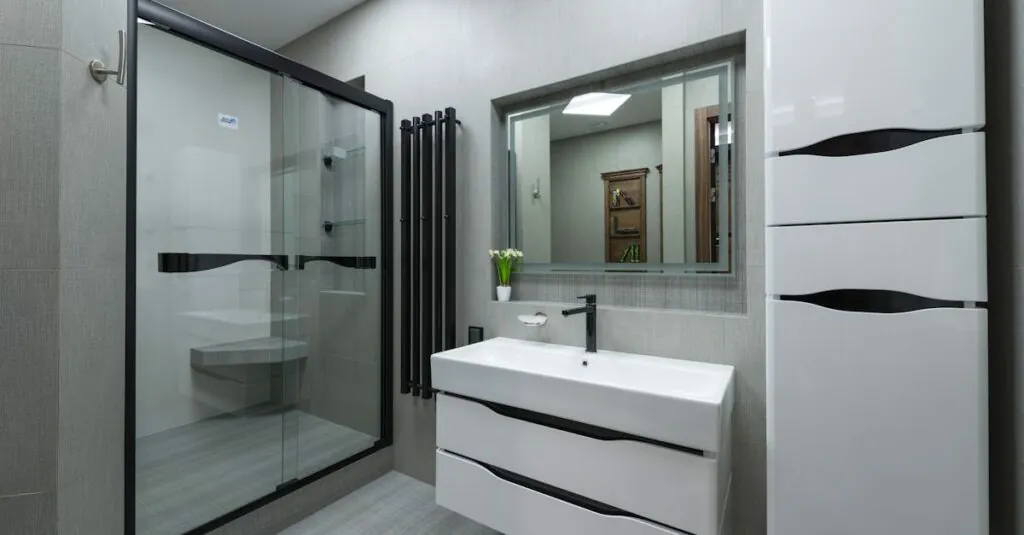Mirrors aren’t just for checking your hair before a big meeting; they’re powerful design tools that can transform any space. Whether it’s making a small room feel larger or adding a splash of style to a dull wall, the right mirror can work wonders. Who knew that a simple piece of glass could hold the key to elevating your home décor game?
From whimsical shapes to bold frames, mirror installation can be as creative as you want it to be. Imagine a gallery wall that reflects not just your taste but your personality too. So get ready to dive into some clever mirror installation ideas that’ll have your guests saying, “Wow, I need to step up my game!” After all, life’s too short for boring walls.
Table of Contents
ToggleCreative Mirror Installation Ideas
Incorporating mirrors into home design offers countless creative possibilities. First, consider a floor-to-ceiling mirror that creates an illusion of height and space in small rooms. Such mirrors strategically placed can brighten dark corners and enhance natural light.
Next, try a mirrored accent wall, which serves as a stunning focal point. This approach works well in dining areas or living rooms, reflecting light and creating an inviting ambiance. Using multiple smaller mirrors in an asymmetrical arrangement also adds visual interest and personal flair.
For those who enjoy a touch of whimsy, explore the option of hanging mirrors in unexpected places. Attaching a mirror to the ceiling in a cozy nook or above a unique piece of furniture invites curiosity and engagement.
In bathrooms, opt for framed mirrors that complement existing décor for a cohesive look. Adding backlighting can elevate these mirrors, creating a spa-like atmosphere.
Another idea includes using mirrors in outdoor spaces. Install weather-resistant mirrors to expand garden views or reflect beautiful landscaping. This transforms outdoor areas into captivating retreats.
Framing mirrors in unconventional materials, such as reclaimed wood or metal, enhances their character. These unique frames can significantly contribute to a room’s overall theme.
Consider mirrors with different shapes, like geometric or circular designs. Placing various shapes in clusters on a wall provides dynamic visual stimulation and personality without overwhelming the space.
Lastly, consider mirrors as functional art pieces. Opt for artistic designs that serve both decorative and practical purposes, catching the eye while being useful.
Practical Considerations for Installation
Careful planning ensures successful mirror installation. Consider these factors to achieve optimal results.
Choosing the Right Location
Positioning a mirror strategically maximizes its impact. Identify a spot that complements room dimensions while enhancing natural light. Reflective surfaces across from windows magnify brightness. Place mirrors in high-traffic areas to create the illusion of more space. Avoid spaces with excessive glare or distracting backgrounds. Assess wall texture and decor to ensure harmony. Testing different heights offers a better sense of what works best for each room.
Measuring and Planning
Accurate measurements are crucial for successful installation. Start by measuring wall space to determine the mirror size. Use a level to ensure perfect alignment. Planning involves sketching potential layouts to visualize placements. Consider wall studs for secure mounting. Taking into account mirror weight helps with hardware selection as well. It’s wise to measure twice before cutting any necessary mounts. Lastly, plan for safety by using appropriate tools and following installation instructions.
DIY Mirror Installation Techniques
DIY mirror installation offers creative ways to enhance home aesthetics. The process requires specific tools and materials for effective execution.
Tools and Materials Needed
Utilize a level to ensure accurate alignment during installation. A tape measure provides precise wall dimensions, aiding in optimal placement. Choose mirror adhesive or heavy-duty mounting tape for secure attachment. Select wall anchors or screws appropriate for the weight of the mirror. A stud finder helps locate wall studs, which provide robust support. Gather safety gear, including gloves and goggles, to ensure a safe working environment.
Step-by-Step Guide to Installation
Start by measuring the wall space to determine the ideal mirror size. Mark the desired position using a pencil, ensuring it aligns with existing décor. Next, if mounting on drywall, drill pilot holes for wall anchors or screws. Use a level to check alignment before securing the mirror in place. Apply adhesive or position mounting tape according to package instructions. Finally, press the mirror firmly against the wall, holding it for a brief moment to ensure adhesion. Always double-check the level before stepping back to admire the new addition.
Utilizing Mirrors for Design
Mirrors serve as powerful design tools, enhancing the style and flow of any space. Floor-to-ceiling mirrors create an illusion of height, which is especially beneficial in compact rooms. Placing these mirrors in dark corners brightens the area and invites more light in.
An accent wall made entirely of mirrors establishes a stunning focal point. Dining rooms and living areas thrive with this bold choice, drawing the eye and setting a vibrant atmosphere. Smaller mirrors arranged in asymmetrical patterns add distinct visual interest to a wall, making the design feel dynamic and engaging.
Unique placements elevate the design further. Hanging mirrors on ceilings or above unique furniture pieces brings whimsy and surprise to a room. Such choices reflect personal style while maximizing the aesthetic appeal.
In bathrooms, utilizing framed mirrors contributes to a spa-like atmosphere. Selecting frames that complement existing décor enhances cohesion and fosters an inviting space. Backlighting behind these mirrors further amplifies this calming effect, creating an elegant glow.
For outdoor areas, weather-resistant mirrors enhance garden views and create pathways that draw attention. Adopting unique framing materials like reclaimed wood or metal adds texture and character to the outdoor experience.
Shape variety also plays a role in effective design. Geometric and circular mirrors invite different feelings and can match or juxtapose other design elements. Mirroring functional art speaks volumes, as these pieces serve decorative and practical purposes.
Choosing the right location maximizes the impact of mirrors. Positioning mirrors to enhance natural light and minimize glare ensures the room feels inviting. Thoughtful design enhances both space and experience, allowing homeowners to seamlessly integrate mirrors into their living environments.
Mirrors can truly redefine a space by adding depth and character. With the right installation techniques and creative ideas, they become more than just reflective surfaces. Whether opting for a dramatic floor-to-ceiling piece or a whimsical arrangement of smaller mirrors, the possibilities are endless.
Each mirror can serve as a unique focal point that enhances the overall design. Thoughtful placement and innovative framing can turn a simple mirror into a stunning work of art. By considering both functionality and aesthetics, anyone can elevate their home décor, making it a reflection of their personal style. Embracing these mirror installation ideas will undoubtedly transform any room into a brighter and more inviting space.





